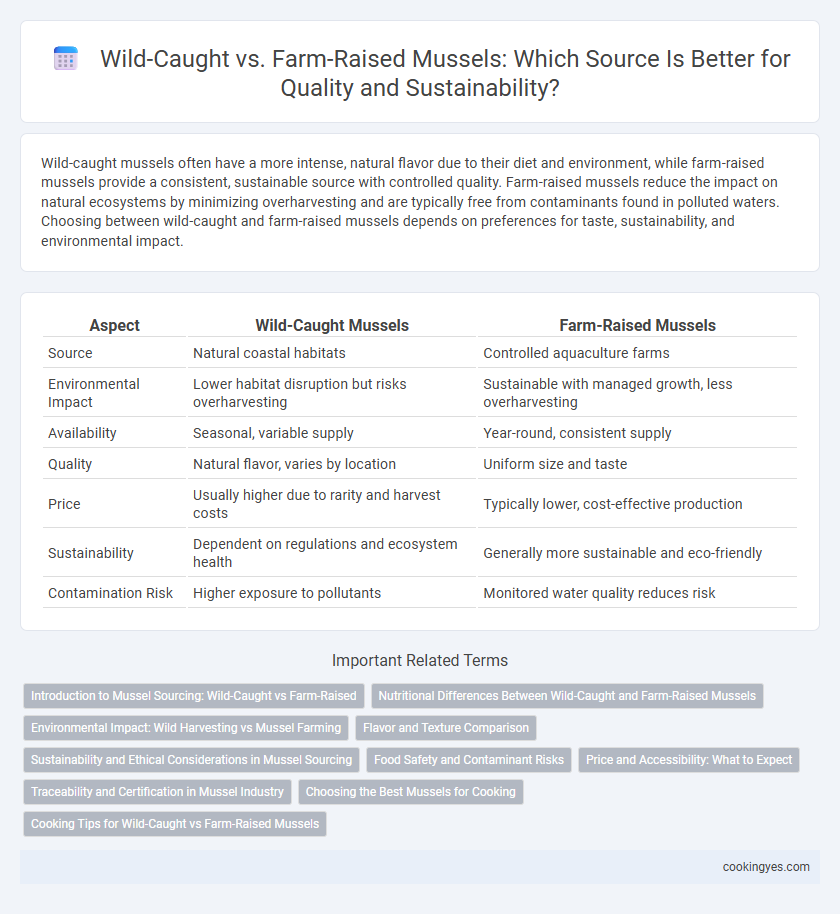Wild-caught mussels often have a more intense, natural flavor due to their diet and environment, while farm-raised mussels provide a consistent, sustainable source with controlled quality. Farm-raised mussels reduce the impact on natural ecosystems by minimizing overharvesting and are typically free from contaminants found in polluted waters. Choosing between wild-caught and farm-raised mussels depends on preferences for taste, sustainability, and environmental impact.
Table of Comparison
| Aspect | Wild-Caught Mussels | Farm-Raised Mussels |
|---|---|---|
| Source | Natural coastal habitats | Controlled aquaculture farms |
| Environmental Impact | Lower habitat disruption but risks overharvesting | Sustainable with managed growth, less overharvesting |
| Availability | Seasonal, variable supply | Year-round, consistent supply |
| Quality | Natural flavor, varies by location | Uniform size and taste |
| Price | Usually higher due to rarity and harvest costs | Typically lower, cost-effective production |
| Sustainability | Dependent on regulations and ecosystem health | Generally more sustainable and eco-friendly |
| Contamination Risk | Higher exposure to pollutants | Monitored water quality reduces risk |
Introduction to Mussel Sourcing: Wild-Caught vs Farm-Raised
Wild-caught mussels are harvested from their natural habitats, offering a diverse nutrient profile influenced by local marine ecosystems, while farm-raised mussels are cultivated in controlled environments with consistent growth conditions ensuring steady availability and quality. Wild-caught mussels often have stronger flavors due to their natural diet, whereas farm-raised mussels provide sustainable options with reduced environmental impact through regulated farming practices. Both sourcing methods supply essential omega-3 fatty acids, protein, and minerals, but consumers should consider factors such as freshness, traceability, and ecological footprint when choosing between wild-caught and farm-raised mussels.
Nutritional Differences Between Wild-Caught and Farm-Raised Mussels
Wild-caught mussels typically exhibit higher levels of omega-3 fatty acids and exhibit a richer mineral profile, including zinc and iron, compared to farm-raised varieties due to their natural diet and environment. Farm-raised mussels often have a more consistent nutrient composition with elevated protein content, attributed to controlled feeding practices. Both sources provide essential vitamins such as B12, but environmental factors influence the bioavailability and concentration of these nutrients.
Environmental Impact: Wild Harvesting vs Mussel Farming
Wild-caught mussels are harvested directly from natural marine environments, often leading to minimal habitat disturbance as they are collected without dredging or trawling, preserving seabed ecosystems. Mussel farming, however, typically has a lower carbon footprint and can improve water quality through filter feeding, but improper farm management risks localized nutrient pollution and habitat alteration. Both methods impact coastal ecosystems differently, with wild harvesting depending on natural population health and farming offering a controlled production system that can reduce pressure on wild stocks.
Flavor and Texture Comparison
Wild-caught mussels typically exhibit a more robust, briny flavor with a firmer, chewier texture that reflects their natural diet and ocean environment. Farm-raised mussels often have a milder taste and a slightly softer, more consistent texture due to controlled feeding and growing conditions. Flavor intensity and textural differences directly impact culinary uses and consumer preferences in seafood dishes.
Sustainability and Ethical Considerations in Mussel Sourcing
Wild-caught mussels are generally considered more sustainable due to their natural growth in marine ecosystems without the need for feed or chemicals, reducing environmental impact. Farm-raised mussels offer controlled production with lower habitat disruption and efficient resource use, but concerns include potential pollution and genetic impacts on wild populations. Ethical considerations prioritize minimizing ecological damage, ensuring responsible harvesting practices, and supporting biodiversity conservation in both sourcing methods.
Food Safety and Contaminant Risks
Wild-caught mussels often have lower risks of chemical contaminants due to their natural filtering process in clean waters, but they may accumulate pathogens from polluted environments, impacting food safety. Farm-raised mussels benefit from controlled aquaculture conditions that minimize exposure to harmful pollutants yet require vigilant monitoring to prevent bacterial contamination from dense stocking. Both sourcing methods demand rigorous testing for marine biotoxins and heavy metals like lead, mercury, and cadmium to ensure consumer safety and compliance with food safety standards.
Price and Accessibility: What to Expect
Wild-caught mussels typically command a higher price due to limited seasonal availability and labor-intensive harvesting methods, making them less accessible in many markets. Farm-raised mussels offer a more consistent supply at lower prices, supported by controlled cultivation environments that reduce seasonal fluctuations. Consumers seeking affordable and readily available mussels often turn to farm-raised options, benefiting from sustainable production practices and stable market presence.
Traceability and Certification in Mussel Industry
Wild-caught mussels often feature robust traceability systems linked to specific harvesting zones, ensuring compliance with environmental regulations and sustainability certifications such as MSC (Marine Stewardship Council). Farm-raised mussels benefit from controlled environments with certifications like ASC (Aquaculture Stewardship Council), guaranteeing traceability through rigorous monitoring of water quality and stock origin. Both sources emphasize certification and traceability to meet consumer demand for transparency and responsible seafood practices in the mussel industry.
Choosing the Best Mussels for Cooking
Wild-caught mussels often carry a richer, brinier flavor due to their natural diet and environment, making them a preferred choice for gourmet cooking. Farm-raised mussels provide a consistent size and quality with a lower environmental impact, ensuring sustainability and affordability. Prioritize freshness, shell integrity, and source transparency to select the best mussels for optimal taste and safety in culinary dishes.
Cooking Tips for Wild-Caught vs Farm-Raised Mussels
Wild-caught mussels often have a firmer texture and more pronounced briny flavor, making them ideal for quick steaming or grilling to preserve their natural taste. Farm-raised mussels tend to be milder and meatier, benefiting from longer cooking methods like baking or incorporating into stews to enhance their sweetness and ensure tenderness. Proper cleaning and debearding are essential for both types to maintain freshness and avoid grit during cooking.
Wild-caught vs Farm-raised for mussel sourcing Infographic

 cookingyes.com
cookingyes.com